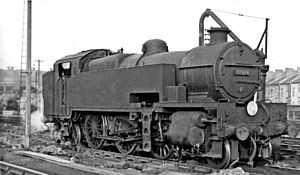SR W class
| SR Class W |

No. 31918 (first batch built June 1935) at Norwood Junction Locomotive Depot 12 March 1960
|
| Type and origin |
| Power type |
Steam |
| Designer |
Richard Maunsell |
| Builder |
|
| Build date |
1930 to 1936 |
| Total produced |
15 |
|
| Specifications |
Configuration:
|
|
| • Whyte
|
2-6-4T |
| • UIC
|
1′C2′ h3t |
| Gauge |
4 ft 8 1⁄2 in (1,435 mm) standard gauge
|
| Leading dia. |
3 ft 1 in (0.940 m) |
|
Driver dia. |
5 ft 6 in (1.676 m) |
| Trailing dia. |
3 ft 1 in (0.940 m) |
| Length |
44 ft 0.25 in (13.42 m) |
| Loco weight |
90 long tons 14 cwt (203,200 lb or 92.2 t)
92.2 t; 101.6 short tons |
| Fuel type |
Coal |
| Fuel capacity |
3 long tons 10 cwt (7,800 lb or 3.6 t)
3.6 t; 3.9 short tons |
| Water cap |
2,000 imp gal (9,100 l; 2,400 US gal) |
| Boiler pressure |
200 psi (1.38 MPa) |
| Cylinders |
3 |
| Cylinder size |
16 1⁄2 in × 28 in (419 mm × 711 mm) |
|
|
|
| Career |
| Operators |
|
| Class |
SR: W |
| Power class |
BR: 5F, later 6F |
| Numbers |
- SR: 1911–1925
- BR: 31911–39125
|
| Withdrawn |
1963–1964 |
| Disposition |
All scrapped
|
|
| Type and origin |
| Power type |
Steam |
| Designer |
Richard Maunsell |
| Builder |
|
| Build date |
1930 to 1936 |
| Total produced |
15 |
| Specifications |
Configuration:
|
|
| • Whyte
|
2-6-4T |
| • UIC
|
1′C2′ h3t |
| Gauge |
4 ft 8 1⁄2 in (1,435 mm) standard gauge
|
| Leading dia. |
3 ft 1 in (0.940 m) |
|
Driver dia. |
5 ft 6 in (1.676 m) |
| Trailing dia. |
3 ft 1 in (0.940 m) |
| Length |
44 ft 0.25 in (13.42 m) |
| Loco weight |
90 long tons 14 cwt (203,200 lb or 92.2 t)
92.2 t; 101.6 short tons |
| Fuel type |
Coal |
| Fuel capacity |
3 long tons 10 cwt (7,800 lb or 3.6 t)
3.6 t; 3.9 short tons |
| Water cap |
2,000 imp gal (9,100 l; 2,400 US gal) |
| Boiler pressure |
200 psi (1.38 MPa) |
| Cylinders |
3 |
| Cylinder size |
16 1⁄2 in × 28 in (419 mm × 711 mm) |
| Career |
| Operators |
|
| Class |
SR: W |
| Power class |
BR: 5F, later 6F |
| Numbers |
- SR: 1911–1925
- BR: 31911–39125
|
| Withdrawn |
1963–1964 |
| Disposition |
All scrapped
|
The SR Class W were 3-cylinder 2-6-4T tank engines designed in 1929 by Richard Maunsell for use on the Southern Railway . They were introduced in 1932 and constructed at Eastleigh and Ashford. The class was intended for short distance, inter-company/regional freight traffic transfer in London, and were standardised with parts from the N, N1, U and U1 classes.
From the 1920s, London was surrounded by a number of large freight Marshalling yards, where long distance freight was brought and re-organised into new trains for onward transmission to its destination. Three of these yards, at Feltham, Norwood and Hither Green were operated by the Southern Railway. The requirement for a fast freight transfer locomotive between these yards, and across London to other railway yards provided a challenge for Richard Maunsell. The electrified suburban lines were busy with commuter traffic that took priority over freight workings, and the London network abounded in junctions and signal stops. The design brief called for a powerful locomotive with good acceleration and adhesion. One that was able to climb the steep gradients over the flying junctions that were to be found all over the Southern Railway's London network. The ability to operate over tight curves and be able to move from a standstill on the aforementioned gradients were also key considerations that needed to be incorporated into the design. A tank locomotive design was also preferable since the journeys were relatively short, and the work would involve frequent changes in direction.
...
Wikipedia

